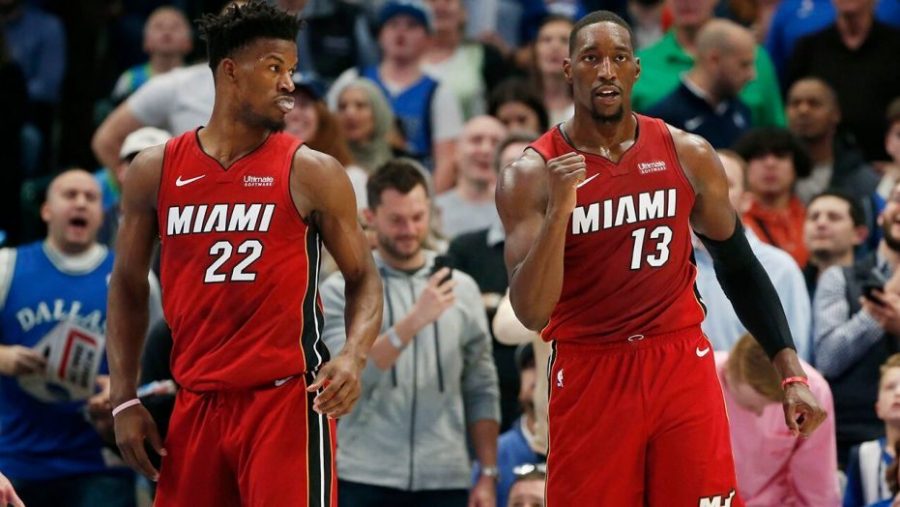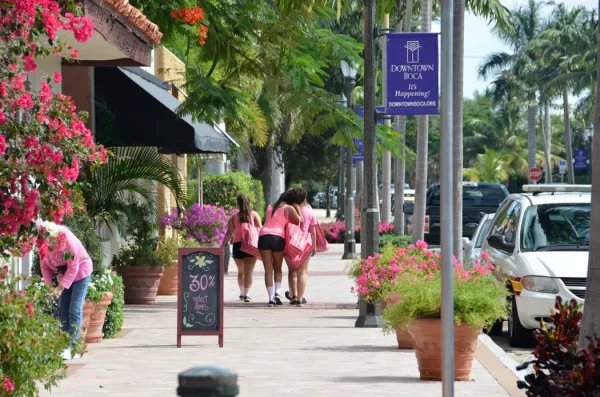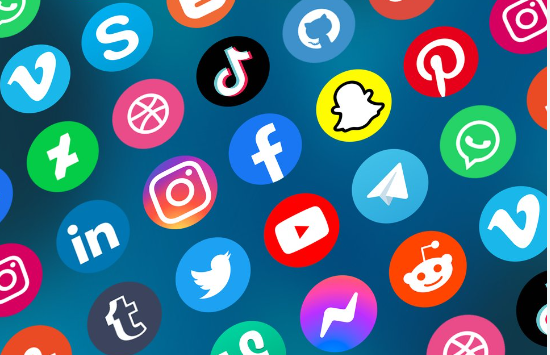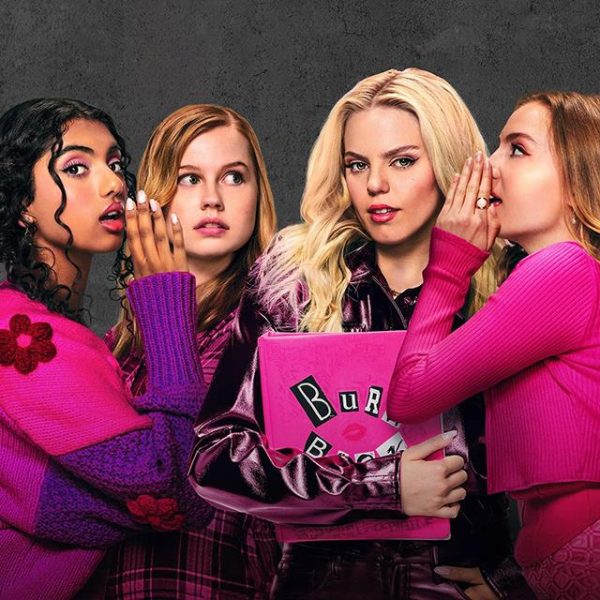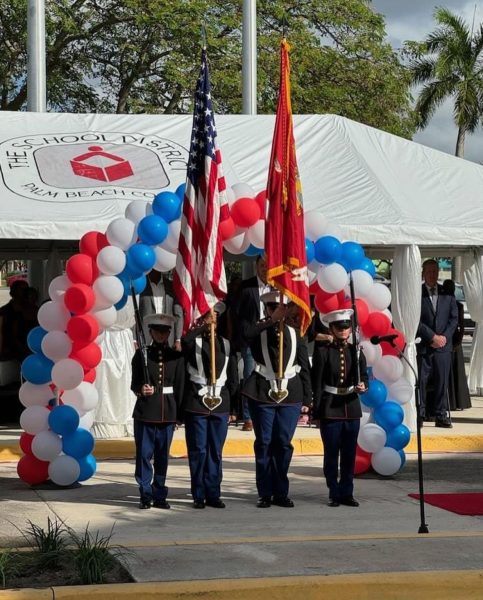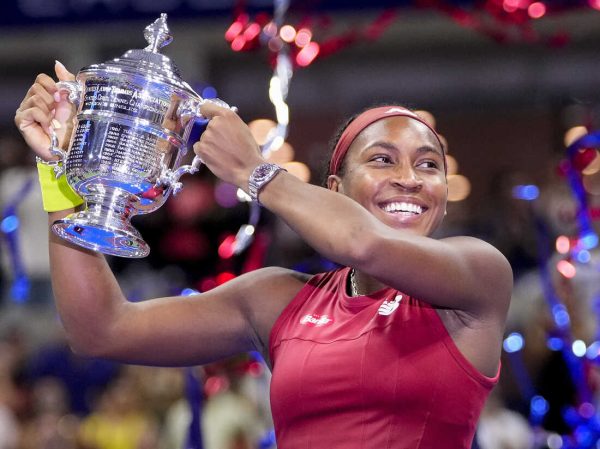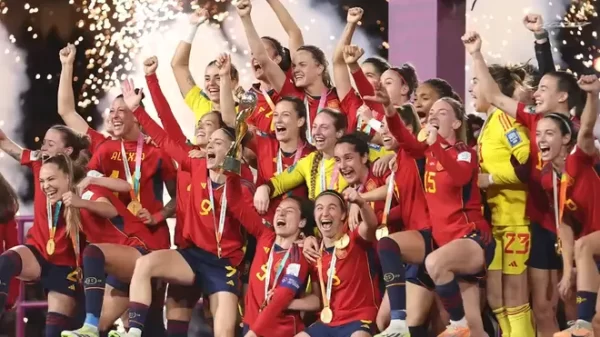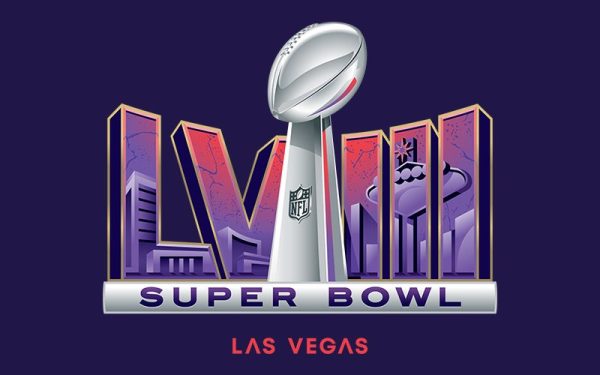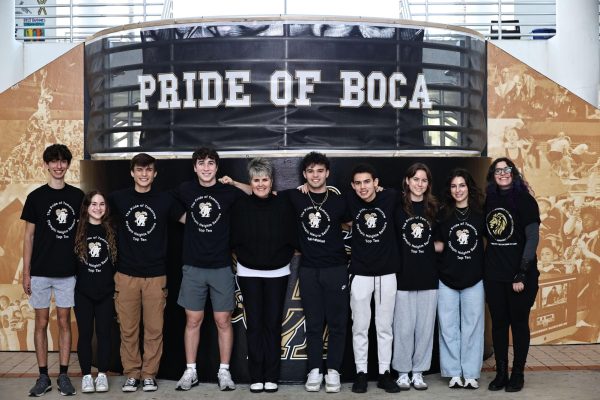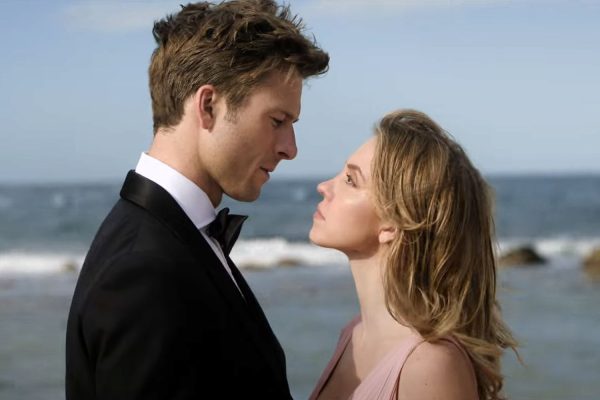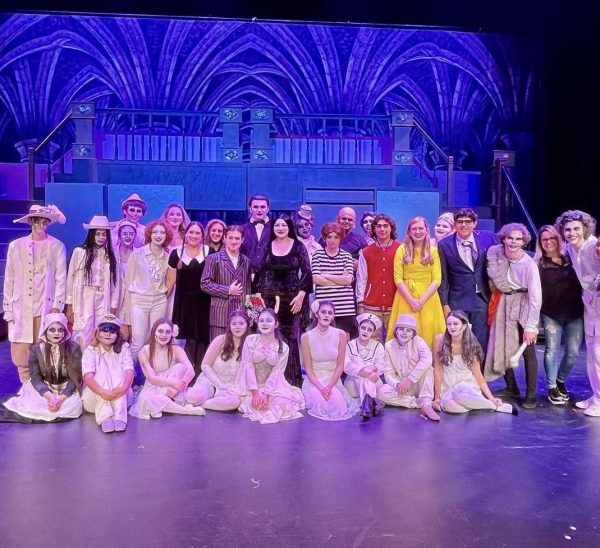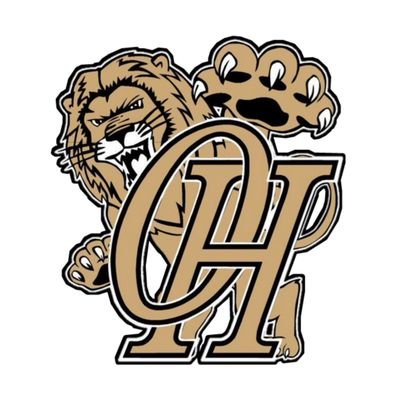The Miami Heat’s improbable road to the NBA finals
Jimmy Butler (#22) and Bam Adebayo (#13) spearheaded the Miami Heat drive to the NBA championship finals.
Since 2014, the Miami Heat have been a symbol of mediocrity in the NBA, having only two playoff appearances and no season with a win percentage over .600 before this season. With LeBron James leaving for the Cleveland Cavaliers and Dwyane Wade aging, the Heat no longer had star power, or anyone on the roster that could contend with some of the NBA’s best and brightest young players.
In 2020, everything changed. The Miami Heat made it back to the NBA Finals once again in what is sure to be written in the history books as one of the NBA’s most unforgettable seasons. So, how did they do it?
2015: It all started in the 2014 offseason when James announced he would be returning to Cleveland to play for his hometown Cavaliers after an incredible four-year run with the Heat. The Heat made the NBA Finals all four of the years James played with them, winning championships twice, in 2012 and 2013. He was the first of the “Big 3” of Chris Bosh, Wade, and himself to leave Miami.
At the 2014 NBA Draft, Miami traded for the draft rights to Shabazz Napier, a promising looking point guard out of the University of Connecticut. Team president Pat Riley and the front office spent the majority of the 2014 offseason signing and re-signing seasoned veterans like Danny Granger, Luol Deng, Chris Andersen, Udonis Haslem, Shawne Williams, and Shannon Brown. The Heat also signed Tyler Johnson to two 10-day contracts, and in those 20 days he proved himself worthy of a roster spot. Also, Hassan Whiteside was called up from the then D-League team the Iowa Energy.
The Heat started the first 52 games of the season 22-3, a poor start that was expected from a team that just lost James. But then, Riley made a bold move at the trade deadline, trading for breakout Phoenix Suns 28-year-old combo guard Goran Dragic and his rookie brother Zoran Dragic. It cost them heavily, though, as they traded away Norris Cole, Justin Hamilton, Shawne Williams, Danny Granger, a 2017 first-round pick, and a 2021 first-round pick.
From that point on, Miami ended the season with a 15-15 record, a definite improvement from before the trade deadline, which kept them in playoff contention. In the end, a loss to the Toronto Raptors in the 80th game of the season sealed Miami’s fate, eliminating them from the playoffs.
Miami would finish 10th in the Eastern Conference that season with a 37-45 record. Their first time missing the playoffs since 2007-2008 before the arrival of Chris Bosh and James. They were also the first team to miss the playoffs after making the finals the previous season since the 2004-05 Los Angeles Lakers.
2016: After a disappointing rookie season, Miami traded Shabazz Napier to the Orlando Magic for a draft pick. They then went on to select Justise Winslow and Josh Richardson in the NBA draft, with Winslow expected to be the new “Face of the Franchise” as Wade and Chris Bosh aged. Speaking of which, contract negotiations between Riley and Wade began to sour. D-Wade had taken a pay cut in 2010 to play with James and form a dynasty as part of the “Big Three,” and now he wanted the payday he felt he was deserving of six years previously. However, Riley disagreed, and they ended up deciding on a one-year $20 million dollar contract to keep Wade in South Florida for at least another year.
The Heat also re-signed Goran Dragic to a massive five-year $90 million contract, and he was worth every penny. He averaged 14 points per game, playing about 33 minutes per game. He was great shooting the basketball, shooting 47.7 percent from the field, and he averaged one steal per game on defense.
Miami also continued their trend of signing aging veteran free agents, In 2016, it was Gerald Green and Amar’e Stoudemire, each inking one year deals. At the trade deadline, Miami dealt away fan-favorite Chris “Birdman” Andersen and point guard Mario Chalmers who played a big role during the James years, but not much thereafter.
On Feb. 9, 2016, Bosh would play his final game in the American Airlines Arena as blood clots would cause him to miss the entirety of the next season and eventually lead to his retirement. Luckily, Whiteside, the third year center, had a breakout season leading the NBA in blocks and blocks per game, with 269 and 3.7 respectively. He also made the All-Defensive second team. Whiteside was beginning to cement himself as a star center in the NBA and a leader on the Miami Heat. He would lead the team to a 48-34 record and the third seed in the Eastern Conference. However, the Heat lost in the Eastern Conference semifinals in a long, seven-game series with the Toronto Raptors.
2017: After sour contract talks soured some more, Wade decided to leave Miami and sign with his hometown Chicago Bulls. For the first time since 2003 when he was drafted, the Miami Heat were going to be playing basketball without Wade. After his breakout campaign, Whiteside signed a four-year, $98 million contract extension, and Miami also re-signed Johnson to a 4-year, 50 million dollar extension after a bidding war with the Brooklyn Nets.
In the first half of the season, Miami did not look good, starting the season with an awful 11-30 record. However, in the back half of the season, Miami went 30-11 to finish 41-41, but it was too little, too late as the Heat ended up missing the playoffs by the skin of their teeth for the second time in three years. One bright spot once again was Hassan Whiteside, who continued to build his reputation as a star center in the NBA. He led the league in total rebounds, averaging 14.1 per game.
2018: In the 2017 offseason, the Heat’s most significant signing was Kelly Olynyk, a shooting big-man, for four years worth $50 million. The Heat drafted undersized, yet athletic center Bam Adebayo from the University of Kentucky with the 14th pick in the draft, though he wouldn’t become a major part of the team until 2020.
Josh Richardson had somewhat of a breakout year. He wasn’t spectacular, but he was consistently reliable as a starter, playing 81 out of 82 games. He was part of a much younger team the Heat rolled with in 2017-18. They had only two players on the roster with over 10 years of experience. Almost like foreshadowing, the Heat finished this season sixth in the Eastern Conference with a respectable 44-38 record, though they would lose to the Philadelphia 76ers in the first round of the playoffs. Maybe a disappointing end to a bit of a surprisingly solid season, but one thing was for sure: the future looked bright.
2019: The 2019 Miami Heat season was a bittersweet one as it was Wade’s “Last Dance.” And this would really be the focus for most of the season as there weren’t many other changes between this year and last. At the trade deadline, Miami dealt 3-point shooting specialist Wayne Ellington and sixth-man Johnson to the Phoenix Suns for aging power forward Ryan Anderson. The trade made little difference for Miami as Anderson only played 10 games. The end of the season had a lot of Heat fans in tears as Wade’s incredible career came to an end and Miami missed the playoffs again, going 39-43 in yet another disappointing season.
2020: The 2020 Miami Heat season is an underdog story for the ages. At the time of the season’s suspension due to the coronavirus on March 11, 2020, the Heat were playing great basketball with a 41-24 record sitting as the fourth seed in the NBA’s Easern Conference. Invited into the NBA’s playoff bubble, there were high expectations for them as they were getting healthy after being plagued by injuries throughout the season.
But before the hiatus, Riley made a series of trades in the offseason, and at the trade deadline and those trades were just what the Heat needed to go the distance. It started on June 20, 2019, when Miami used the 13th overall pick in the NBA draft to select Tyler Herro, their second draftee from the University of Kentucky in as many years. Praised for his lethal shooting ability, there was skepticism about Herro’s defensive ability.
Then, just 17 days later, Riley participated in a four-team sign-and-trade deal with the Philadelphia 76ers, Portland Trail Blazers, and Los Angeles Clippers that sent Whiteside to Portland, Richardson to Philadelphia, and brought Jimmy Butler and Meyers Leonard to South Beach.
Miami and Butler had an instant love connection and he proved why he was worth every penny of the four-year $142 million contract he was awarded with. After he left Chicago, Jimmy never looked the same. After two short stints with Minnesota and Philadelphia, Butler came to Miami and finally got his career back on track.
Once again starting the season with only two players on the roster with 10+ years of experience, Butler came in and provided superstardom and mentorship to Miami’s young, developmental core. Speaking of the young core, Miami’s player development staff proved this season why they’re the best in the NBA. 22-year-old third year pro Adebayo had a breakout season, averaging 15 points, 10 rebounds, and 5 assists per game.
At 6’10”, Adebayo is undersized for a center, but this year he learned to use his incredible athleticism to his advantage, making himself a force to be reckoned with in the paint for opposing centers. Adebayo cemented himself as a top-five center in just his third year in the NBA. He was also the runner up for the Most Improved Player award, losing to Brandon Ingram of the New Orleans Pelicans.
Miami signed undrafted free agent and Summer League star Kendrick Nunn to the team this season, as well as another undrafted free agent in Duncan Robinson. Nunn came in and proved himself to be a worthy starting guard in the NBA while vetern Dragic was injured. Robinson became a household name as he proved himself to be one of the NBA’s best three-point shooters.
Finally, Herro came in and did exactly what was expected of him and then some. He proved to be a reliable shooter, especially in crunch time late in games. Herro was a clutch shooting phenom, and proved all his haters wrong.
At the trade deadline, Miami dealt former first round pick Justise Winslow and failed experiment Dion Waiters to the Memphis Grizzlies in exchange for 16-year veteran and former finals MVP Andre Iguodala, sharpshooter and veteran Jae Crowder, and bench piece Solomon Hill. With this trade, it was obvious that Riley had great faith in his team, and thought with one more difference player, his team could compete for and even win a championship.
During the eight “seeding games” in the bubble, players like T.J. Warren, Damian Lillard, and Devin Booker stole the show as the Heat went a rough 3-5 and fell to the fifth seed in the Eastern Conference. However, once the playoffs came around, the Miami Heat looked like a completely transformed team.
They swept the fourth-seeded Indiana Pacers 4-0 with ease in the first round of the playoffs. They then beat the number one seeded Milwaukee Bucks in five games in the second round. This was a Bucks team that many regarded as the best team in the NBA because of their star player Giannis Antetokounmpo.
After the Milwaukee series, the Heat finally started earning the respect they deserved. Butler and Dragic guided the team with veteran leadership. Butler, specifically, played a hefty 38 minutes per game, averaging 22 points, six rebounds, and six assists per game. But he really helped the Heat by drawing plenty of fouls, averaging nearly eight free throws per game in the playoffs.
Robinson and Herro contributed spectacular perimeter shooting off the bench. Adebayo owned the paint on both ends of the floor in the playoffs, including making a key block on Jayson Tatum of the Boston Celtics in the Eastern Conference Finals series. Adebayo averaged 17 points and 10 rebounds per game in the playoffs, playing an average of 36 minutes per game.
This team proved many people wrong, taking a young squad of mid-first round draft picks, undrafted free agents, and Butler all the way to the NBA finals where they would end up losing in six games to the juggernaut James and Anthony Davis-led Los Angeles Lakers. However,two wins in the finals was more than any other team that faced the Lakers in the playoffs had managed. The Lakers had won all three of their previous series in five games, but the Heat were able to win two games against them after going winless against them in the regular season.
And the Heat should only get stronger for the 2020-2021 season. Miami has been saving cap space for the 2021 free agency market which includes aforementioned superstar Antetokounmpo, who the Heat have expressed very strong interest in.The hope of Heat fans alike is that with the addition of Antetokounmpo, the Heat will finally have enough to not only make it to the finals, but bring the NBA championship back to South Florida.


